The 50 Best Slasher Movies of All Time

What do you think of, when you read the words “slasher movie”?
A killer in a mask, perhaps. A group of horny, not-so-bright teens in a secluded setting, sure. Gallons and gallons of red tempera paint or corn syrup—that’s almost a given. But more than anything, slasher movies are an exploration of intimacy—the intimacy and invasiveness of physical violence in our lives, and “the morbid intimacy in the act of killing,” as one Paste staffer recently put it in a discussion of the genre.
What’s more complicated is properly defining “slasher,” and deciding when exactly the genre began. From the time of Universal’s The Old Dark House in 1932, Hollywood has been producing films about groups of people being stalked by mysterious killers in a confined setting, and yet we don’t necessarily reevaluate that film as “the first slasher.” Films of the ’40s and ’50s such as And Then There Were None, House of Wax and The Bad Seed incorporated many of the same themes, but it might be fair to say that they lacked the lurid quality that truly makes for a “slasher”—the exploitative edge and shock factor mined by true slashers such as Black Christmas and Halloween in the ’70s and beyond. In an extended investigation of this question, we eventually landed on a little-known Italian horror film from 1973 as the first genuine “slasher movie.”
So, then: Before we embark on listing the 50 best slasher movies of all time, our task is clear. We need a concrete “slasher movie” definition.
Defining “Slasher Movie”
1. Slasher villains are human
The likes of Ridley Scott’s Alien make for an interesting inclusion on slasher-centric lists, but the unknowable, alien intelligence of the xenomorph removes that intimacy we referenced earlier, which demands a human (or at least formerly human) killer whose actions are objectively “evil.” The xenomorph may be crafty and terrifying, but it’s still a “monster” or “beast” lacking human conscience, as is a werewolf, or the Predator, or a killer shark on the loose. They’re all horror films, but they’re not slasher films.
2. Slasher films have a body count
Slasher villains are never one-and-done. They need at least a modest group of potential victims, and they often need to rack up a few early kills to establish both their modus operandi and threatening credibility. A slasher villain may primarily stalk a single protagonist through the course of a film, but he cuts a path through others in order to get there, because it’s the kills themselves that the audience is there to see.
3. Home invasion movies are not automatically slasher movies
Many home invasion movies, such as The Strangers or Hush, share common elements with the slasher genre. The killers in both films wear masks, for instance, but in both cases they’re stalking a single woman in the confines of her own home, violating the group nature and “body count” rules necessary to slashers. As another Paste writer put it during our discussion: “I draw a big distinction between home invasion and slashers, even though they have so much in common. Home invasion movies operate more on tension than violence. The Strangers is an exercise in suspense rather than gore. Slashers generally focus on turning murder into a creative exercise.”
So with those parameters in mind, let’s get to the slashing.
50. Silent Night, Deadly Night Part 2 (1987)
Director: Lee Harry

We’d like to start off with a film that both typifies the sequel-laden late ’80s slasher genre and illustrates its pitfalls: The woeful Silent Night, Deadly Night Part 2, known more at this point for its infamous “garbage day!” meme fodder than anything else. As a sequel that was highly constrained by budget, it spends the vast majority of its runtime simply re-hashing footage from the run-of-the-mill original installment of this “killer Santa Claus” franchise, but it’s the sequences of Part 2 that venture off onto their own that truly make it an absurdist camp classic. In particular, actor Eric Freeman as serial killer “Ricky” leaves an unforgettable impression for how genuinely and haplessly out of his depth he appears to be throughout. It’s a bad performance for the ages—Freeman’s stilted and hesitant delivery of what are meant to be the menacing words of a psychopath can never hide the clear anxiety written on his face through every frame. As the film runs on, there’s an increasingly surreal thread that worms its way to the surface, exemplified by the scene wherein Ricky goes to a movie theater and somehow manages to watch segments from the first film on the screen, despite the fact that the original killer was supposed to be his brother. If you’re programming a “bad Christmas movies” lineup, Silent Night, Deadly Night Part 2 is essential viewing. —Jim Vorel
49. Pieces (1982)
Director: Juan Piquer Simón
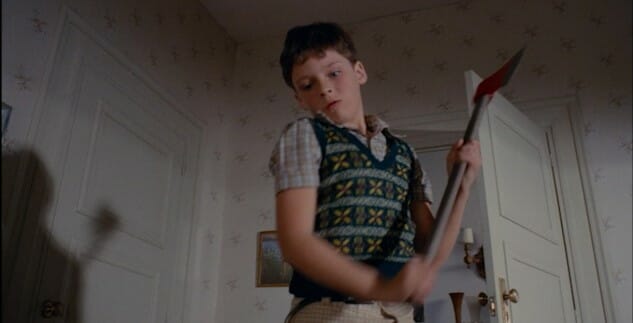
Pieces is the sort of silly, head-scratching early ’80s slasher wherein it’s difficult to decide if the director is trying to slyly parody the genre or actually believes in what he’s doing. Regardless, Pieces is a delightfully stupid movie, featuring a killer who murders his mother with an axe as a child after she scolds him for assembling a naughty adult jigsaw puzzle. All grown up, he stalks women on a college campus and saws off “pieces” in order to build a real-life jigsaw woman. The film’s individual murder sequences are completely and utterly bonkers, the best one being a sequence in which the female lead is walking down a dark alley and is suddenly attacked by a tracksuit-wearing “kung fu professor” played by “Brucesploitation” actor Bruce Le. After she incapacitates him, he apologizes, saying he must have had “some bad chop suey,” and waltzes out of the movie. The whole thing takes less than a minute. Pieces also boasts one of the best film taglines of all time: “Pieces: It’s exactly what you think it is!” As schlock goes, it’s an unheralded classic. —Jim Vorel
48. Hell Night (1981)
Director: Tom DeSimone
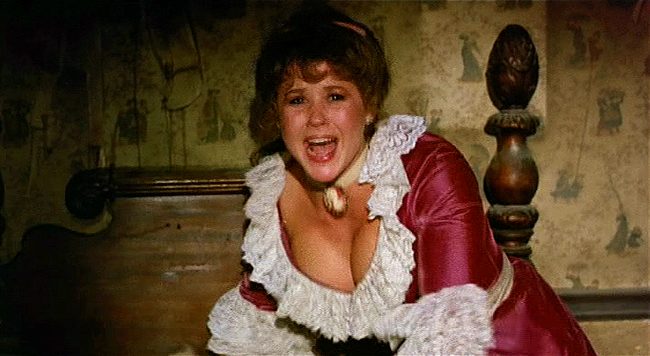
1981 was almost certainly the most prolific single year of the early 1980s slasher boom, but already by this point some of the films were getting a bit on the derivative side. Hell Night is one that stands out mostly for its oddities—a “college hazing” story that feels like the result of a producer wondering what would happen if you mixed the emergent slasher genre with older horror film styles, like Hammer gothic horror films and American “old dark house” films of the 1930s-1940s. Consequently, the cast of young college students spending the night in abandoned “Garth Manor” are dressed in frilly period clothing, which gives an odd flavor to a film about these teens being stalked by the still-living, deformed monster known as “Andrew Garth.” Designed as a star vehicle for Linda Blair (in full-on Jamie Lee Curtis mode), 8 years after The Exorcist, it’s a bit uncomfortable to watch a grown-up Regan rocking some gaudy cleavage, but her performance really isn’t as bad as contemporary audiences made out—certainly not deserving of the Razzie Award for which she was nominated, anyway. The direction and production design, meanwhile, are actually quite good, taking advantage of the unusual slasher film setting with some atmospheric lighting and moody set-ups. As for “Andrew Garth,” he’s a pretty stock slasher villain of the day, with little motivation besides “kills people who come to Garth Manor,” but at least he gets a memorable denouement. —Jim Vorel
47. Happy Death Day (2017)
Director: Christopher B. Landon
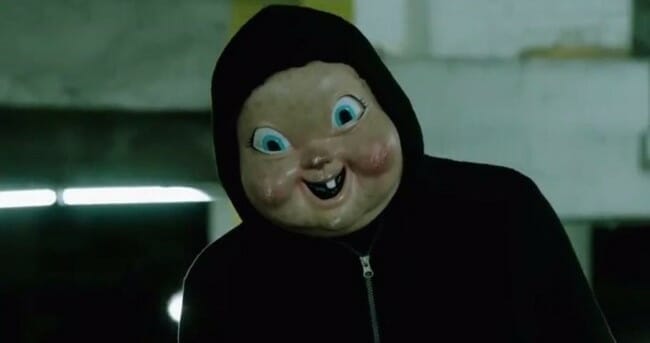
Happy Death Day is the sort of film that is both propped up and constrained by its high-concept premise—you know within moments that it was pitched in a boardroom as “Groundhog Day meets Scream,” and that a bunch of middle-aged white executives nodded accordingly and began appropriating funds and looking at headshots of attractive young women. Still, it has a few things going for it. Jessica Rothe is charming as protagonist “Tree”; the film is by and large a bit funnier than it needs to be; and it does a good job of drawing the audience in with the promise of an expected conclusion before pulling the rug out from beneath them in the last few minutes. It’s an easygoing, not-too-gory entry into the smart-alecky slasher canon, but not a bad way to kill a weekend afternoon. It’s hard not to question whether its eventual sequel is really warranted or narratively feasible, given the time-looping nature of the original story, but that didn’t stop director Christopher Landon from delivering it. If you ask us, Happy Death Day seems more like a one-and-done proposition, best left to stand on its own. —Jim Vorel
46. Fear Street Trilogy (2021)
Director: Leigh Janiak

There’s a bevy of different ways a singular slasher film or entire franchise might stand out from the pack, but sheer ambition is rarely one of them. For all their charms, the slasher genre has a tendency to be staid and not the most imaginative, outside of the outlandish kills—as for basic structure, fans pretty much want to see the established beats honored and cycled through. That was part of what made director Leigh Janiak’s (of the underrated Honeymoon) Fear Street trilogy from Netflix such a pleasant surprise—a deeply interconnected and surprisingly complex, ambitious trio of slasher throwback tributes, which all weave together to form a larger, time-traveling whole. The period touches are nice in all installments, but together they become greater than the sum of their parts, displaying a sense of forethought and planning that one just doesn’t see often in this horror subgenre. And of course, it helps that the kills are quite legitimate as well, occasionally pushing the boundaries of what one expects to see in a Netflix original. In one of the highlights from first entry Fear Street: 1994, a character’s head has a rather unpleasant encounter with a supermarket bread slicer, and it’s genuinely shocking to see Janiak stay with the shot instead of cutting away to a generic blood splatter. Good on her for staying the course, and delivering a new kind of ambitious slasher storytelling. —Jim Vorel
45. Maniac (1980)
Director: William Lustig
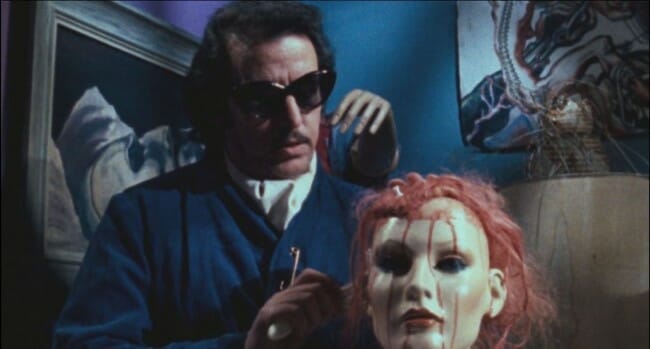
There’s a certain “griminess” to certain ’80s horror films that is best exemplified by films such as Henry: Portrait of a Serial Killer (horror, but not a true “slasher”) and the original 1980 Maniac by William Lustig. It’s an aesthetic of ugliness both intentional and incidental—with a tiny budget, large portions of Maniac were shot guerilla style and without filming permits, giving it a stalker-ish vibe that is visually matched on screen by Joe Spinell’s greasy, psychopathic serial killer. This isn’t so much a film about characters as it is vibe, although it does have the odd distinction of reuniting Spinell and the voluptuous Caroline Munro, two years after they appeared in the legendarily silly Starcrash. Rather, Maniac is the unsettling descent into madness of a single outsider, capped off by a classic bit of Tom Savini gore-craft, when Spinell’s killer leaps onto the hood of Savini’s car and blows his head to smithereens with a point-blank shotgun blast. —Jim Vorel
44. In a Violent Nature (2024)
Director: Chris Nash
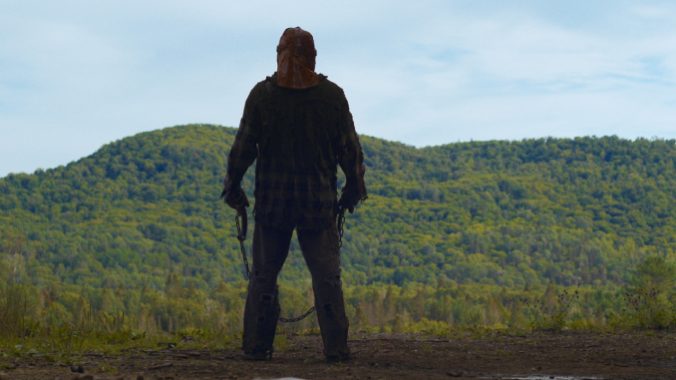
When In a Violent Nature’s boogeyman (Ry Barrett) rises to spill the blood of campers who’ve wandered into his wood, it doesn’t have the look or feel of a horror movie. The forest is serene, shot as if its lumbering antagonist was just another part of nature. With gorgeous bright greens and a commitment to fully viewing its muddy, ragged creature design, In a Violent Nature isn’t hiding anything. Confident, imposing, bright daylight photography is more concerned with establishing an unassuming setting. We trudge past the inherently uncanny human rot lost out in the woods: A gutted shed, a burned tower, a rusted-out car. All the while, the killer lurches along, the camera at his back, in quiet pursuit of those unlucky enough to have disturbed him. And I do mean quiet—there’s only diegetic music in this film, adding tremendously to its methodical atmosphere. The daylight stuff is so imposing and confident that, when it flows into night, the fading visibility is so organic that it sneaks up on you. That’s not to say Nash and team try to take advantage of us in the dark. Some of the best, inventive and juicy kills come bright and early. The gruesome, delightfully disgusting kills are as nonchalant as they’d be for this creature—even the most elaborate and ridiculous (and they do get elaborate and ridiculous) play like he’s working through a set of crunches. And boy, do folks get crunched. —Jacob Oller
43. Halloween 4: The Return of Michael Myers (1988)
Director: Dwight H. Little
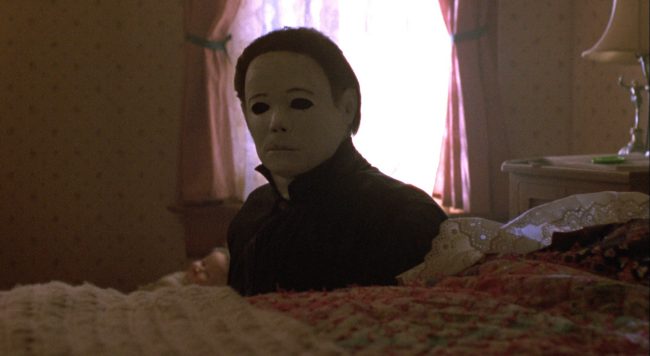
Halloween 4 is a deeply divisive film even today, and many horror fans still seem unwilling to go to bat for it. The return of Michael Myers to the franchise after Halloween 3: Season of the Witch’s misanthropic diversion into the anthology format was a move that initially pleased fans of the original Halloween, but the years that followed have not been kind to Halloween 4’s reputation. However, we are here to defend it: This is arguably a more entertaining film than first sequel Halloween 2, and one that gets an above-average horror movie performance out of Danielle Harris as Jamie Lloyd, who was only 9 at the time. Michael is at his menacing best, especially in the early dream sequence in which he emerges from beneath Jamie’s bed, and Donald Pleasence as Dr. Loomis is more histrionic and hyperbolic than ever as he insists—loudly and constantly—that Myers is a monster that must be destroyed once and for all. Halloween 4 is even blessed with one of the more legitimately shocking endings to an ’80s-era slasher film … but one that was unfortunately retconned at the beginning of Halloween 5 after producers got cold feet about committing to its consequences. In the end, that association with Halloween 5 (and don’t even get us started on Halloween 6) is the anchor around the neck of Halloween 4, but judged solely by its own merits, it deserves to be here. It also arguably contains more over “Halloween” holiday theming than any other entry in the series, making it feel particularly at home in the month of October. —Jim Vorel
42. Prom Night (1980)
Director: Paul Lynch

It is perhaps odd to think, in the post-Jason Voorhees era of slasher villains, that slasher killers of the early ’80s were often weirdly justified in their slayings. Sure, there are some “escaped maniacs on the loose,” but many are basically avenging angels, punishing groups of young people for a terrible crime they tried to sweep under the rug, with Prom Night standing as one of the classic examples. Starring Jamie Lee Curtis in her first slasher role after Halloween, Prom Night knows it’s trying to cash in on that earlier film’s success, but it also manages to stand on its own, inspiring imitations all the way to I Know What You Did Last Summer. Portions of the film are kind of rote, and even the best-looking versions you can find today have a soft, gauzy quality that makes the picture look a little strange, but when Prom Night is good, it’s great. Oddly, it’s not really Curtis who gets the best sequences, but actress Eddie Benton as Wendy, who participates in one half of what is maybe the best (and certainly most formative) chase sequence in the history of the horror genre. Stalked by an axe-wielding killer in a ski mask, the frenzied, eight-minute scene spools out for an eternity as Wendy is chased through the locked, echoing halls of the high school, illuminated in impressionistic, Argento-esque shafts of red light. Not all of Prom Night can live up to it (the disco dance sequences are dreadful), but the chase alone makes it a classic. —Jim Vorel
41. Terror Train (1980)
Director: Roger Spottiswoode
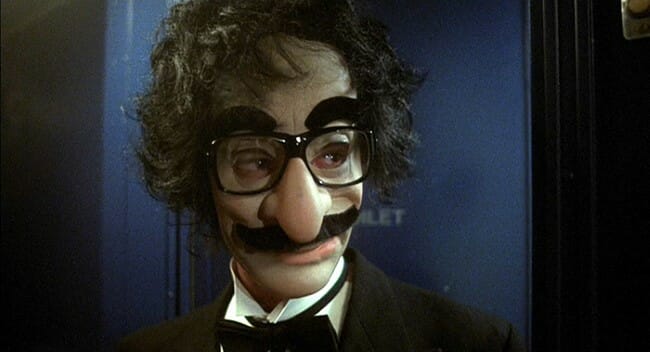
The executive producer of Terror Train reportedly instructed his crew to make “Halloween on a train,” and although you can at times feel the effort being made, John Carpenter this ain’t. Without the atmosphere provided by one of horror’s greats at the helm, this film instead has to rely on concept, location and casting—namely, the presence of scream queen Jamie Lee Curtis as the lead, right after she had finished shooting the very similar Prom Night. Today, this mostly run-of-the-mill slasher is buoyed by several oddities: First, by the fact that magician David Copperfield is present, literally playing a magician red herring; and secondly by the novel concept of a masked killer who is regularly switching masks throughout the movie, leaving the characters guessing. If you’ve seen it, you know there’s something about a killer in a Groucho Marx mask that is oddly mesmerizing. —Jim Vorel
40. The Slumber Party Massacre (1982)
Director: Amy Holden Jones
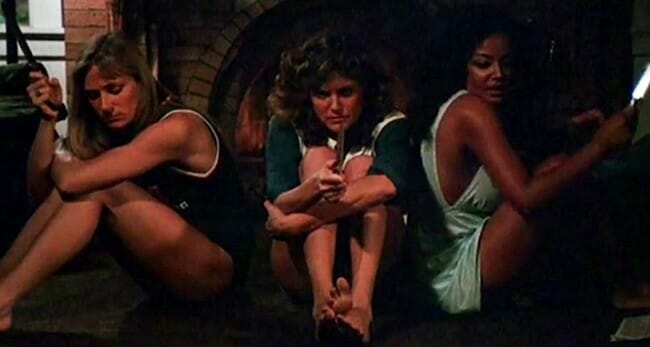
The Slumber Party Massacre is a classic early ’80s cheesefest that holds the distinction of being one of the few slasher movies from the golden age of the genre that was actually directed and written by women—Amy Holden Jones and Rita Mae Brown, respectfully. In fact, Brown originally wrote the film as an early parody of the genre, playing off the tropes established by Halloween and Friday the 13th, but the movie was ultimately filmed as a legitimate horror vehicle instead, leaving it in a unique tonal middle ground that retains a fair amount of black comedy. As a result, it’s a trope-laden film that sees the denizens of the titular slumber party stalked by an escaped maniac (always a popular option, when you don’t want to write a killer’s backstory) armed with a power drill, à la 1979’s The Driller Killer. Ironically, despite being intended as parody, the film ended up establishing a number of “slumber party” horror movie tropes itself, the residuals of which echoed through the slasher genre for a decade to come. It’s also unusual in the sense that it has more than one character who could properly be labeled as a “final girl,” allowing for some tandem offense against the killer. —Jim Vorel
39. Intruder (1989)
Director: Scott Spiegel

The slasher genre was winding down and becoming increasingly silly and comedy inflected by the time Intruder arrived in 1989, but this supermarket-based tale instead hews very much to the mold set earlier in the decade—it’s thoroughly conventional, makes a legitimate attempt to be scary, but mostly stands out for the sheer brutality of its death sequences and gory kills. Directed by longtime Sam Raimi associate and Evil Dead II co-writer Scott Spiegel, Intruder has a somewhat scraped-together feel to it, but it benefits from its unique grocery store setting, as the entire production was filmed in the evenings in an actual supermarket. Both Raimi brothers are here on screen, both destined to become corpses, and even Bruce Campbell pops in for a brief cameo. What makes Intruder stand out, after a fairly tepid opening (and obvious red herring setups), is its incredibly gross and over-the-top deaths, which are delivered via practical effects that are genuinely disturbing. If you’re a seasoned slasher buff, you’ve probably seen things like a head being crushed, or a man’s face being sawed in half, but you probably haven’t seen it shot in nearly such a gross and unflinching way as it is here, I assure you. How Intruder ultimately bore an “R” rather than “X” rating is anyone’s guess, but it remains an underrated entry among late 1980s slashers that is far more brutal than most of the competitors of this particular moment in the genre’s history. —Jim Vorel
38. April Fool’s Day (1986)
Director: Fred Walton
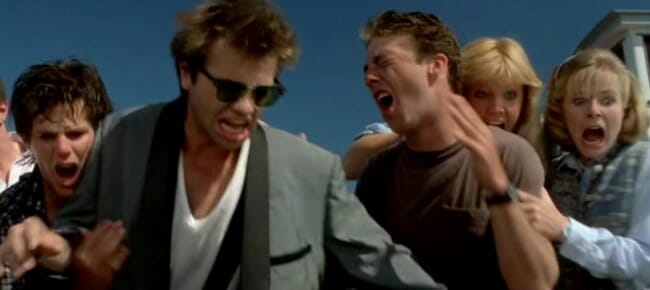
April Fool’s Day is rote, until it isn’t; predictable until it turns the tables, and very difficult to assess as a result. It begins with a setup that would be at home in just about any early ’80s slasher, lining up potential red herrings aplenty, and then proceeds in businesslike fashion from there, slowly picking off members of a group of young people who are spending spring break together at a remote island mansion. In fact, the violence of April Fool’s Day stands out for how chaste it seems throughout most of its runtime, to the point where it will likely perplex viewers … right up until they understand the reason for it. Ultimately, this is one of those films you can’t talk about without discussing its ending, and whether or not the audience chooses to accept that ending—and the massive logical gaps it immediately highlights—is going to be the determining factor in whether someone chooses to describe April Fool’s Day as “innovative” or “cheap.” We could go either way, but at the very least, it features some of the better performances you’ll find in this genre in the ’80s, including Thomas F. Wilson, one year after he played “Biff” in the first entry of the Back to the Future trilogy. —Jim Vorel
37. Halloween II (1981)
Director: Rick Rosenthal
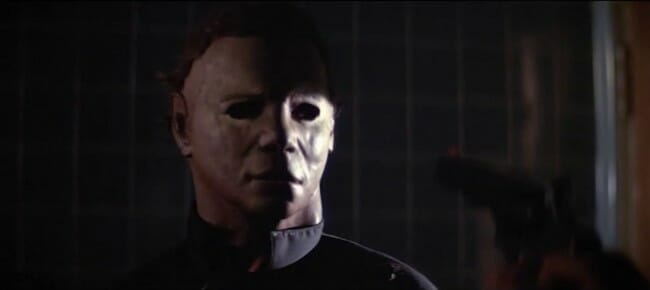
Halloween 2 is an odd beast. Written by John Carpenter and Debra Hill, but instead directed by Rick Rosenthal, it displays some of the stylistic flair of the original while confining the action almost entirely to a single setting, the hospital where Laurie Strode (a returning Jamie Lee Curtis) is taken immediately after the events of Halloween. The violence is more overt, and the blood flows more freely than in the largely atmospheric and bloodless original, but there’s an odd sort of pallor over the film as a whole—it feels cold, wan and “abandoned.” Perhaps that’s because the hospital setting, typically filled with a bustling jumble of patients, doctors and nurses, is depicted here as a veritable ghost town, but it’s also because the characters of Halloween II suffer in comparison with the original, even if that includes a ditzy P.J. Soles. Halloween II has now been rendered apocryphal by the upcoming Halloween sequel, as has the revelation that Laurie Strode is supposed to be Michael Myers’ sister, but in the context of the film that review hardly seems to matter much. What does stand out in Halloween II is the classic final confrontation between Myers and Dr. Loomis, as both are consumed by a fire that was supposed to be the end for both characters. It would have been a fitting end. —Jim Vorel
36. Urban Legend (1998)
Director: Jamie Blanks
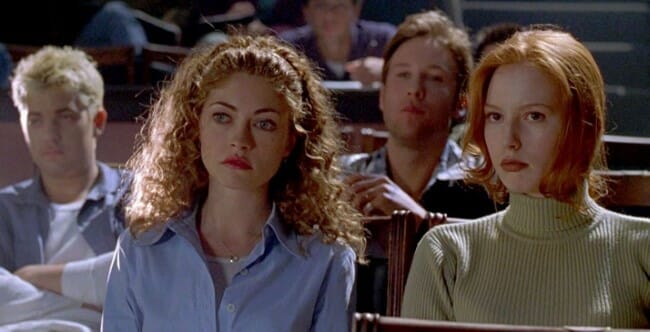
Urban Legend is one of those late 1990s slashers that cropped up in the wake of Scream and its sequels, and considering its meta-slasher leanings, it’s almost impossible to discuss Urban Legend without noting the context of Scream, as reviewers certainly did at the time. Despite the similarities, though—especially to 1997’s Scream 2, as both occur on a college campus—Urban Legend is mining subtly different territory, being something of an ode to the oral tradition of scary stories rather than paean specifically to horror cinema. With that said, it does feature some great horror geek cameos, from the obvious inclusion of Robert Englund as a creepy professor teaching a course on urban legends, to Brad Dourif as a suspicious gas station attendant or Halloween 4’s Danielle Harris as a promiscuous, gothy roommate. Urban Legend can also boast fun, silly deaths based in pop culture lore, like the infamous “Pop Rocks and drain cleaner” combination used to dispatch one particularly unlucky soul. Overall, the film is a brisk watch that is never anything less than entertaining, equipped with a seemingly obvious supply of red herrings to keep you occupied until it barrels through a conclusion that seems obvious in hindsight, but is all good fun in the moment. —Jim Vorel
35. Torso (1973)
Director: Sergio Martino
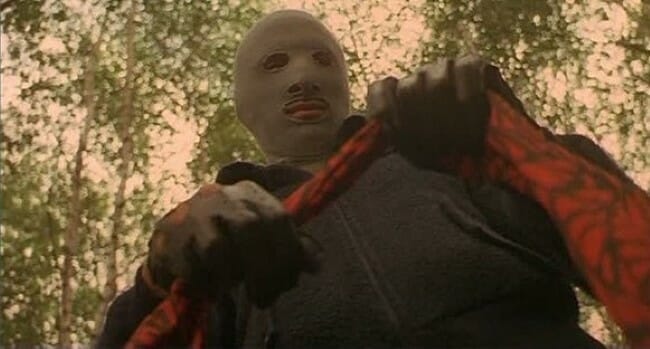
Whereas the peak films of Dario Argento (or even Lucio Fulci and Mario Bava, at their best) are assessed with a certain critical goodwill in mind, the same is not true of what one might call the true giallos, those dime-a-dozen proto-slasher mysteries that more accurately captured the spirit of the yellow paperbacks from whence they sprung. Torso certainly feels like one of those lurid, gaudy films, although director Sergio Martino does infuse it with a certain artistic flair, especially in the depiction of the stocking-faced killer, whose blank gaze is more than a little disturbing … as is his penchant for sawing women apart. Still, Torso is as exploitative as the title no doubt sounds, with plenty of nudity and a hedonistic, Bohemian attitude periodically punctuated by strangulations. If there’s one scene in particular that stands out, it’s the poor final girl watching from a hiding place, powerless to stop the killer as he begins to brutally dismember her friends. Few scenes so well capture the voyeuristic terror of witnessing a crime unfolding. —Jim Vorel
34. The Final Girls (2016)
Director: Todd Strauss-Schulson
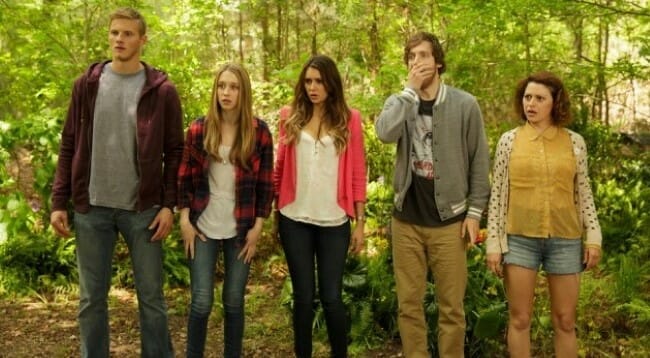
It’s rather difficult for a genuine slasher film to be “sweet,” but this horror comedy manages that odd distinction. The Final Girls is about a young woman named Max (Taissa Farmiga), whose deceased mother was a scream queen actress known for her role in an ’80s Friday the 13th parody called Camp Bloodbath. While attending a screening of Camp Bloodbath with some friends, a mysterious incident leads to Max and company being somehow sucked into the movie, where she’s reunited with her mother … and the film’s Jason-esque killer. Thus, The Final Girls presents the unique scenario of a group of teens being aware of the fact that they’re in a slasher movie, who are thus armed with the knowledge of the genre’s tropes, attempting the flip the script on how it will all play out. Frequently clever, but surprisingly heartfelt, The Final Girls benefits more than anything from a stellar supporting cast of comedic actors, from Malin Åkerman and Alia Shawkat to Thomas Middleditch and Adam DeVine, who all elevate what could easily have been an overwhelmingly chintzy premise into a genuinely enjoyable (if lightweight) horror comedy romp. The Final Girls isn’t the kind of film that will ever be hailed as a cult classic in its own right, but as genre parodies go, it’s among the best that slashers have to offer. —Jim Vorel
33. Child’s Play (1988)
Director: Tom Holland
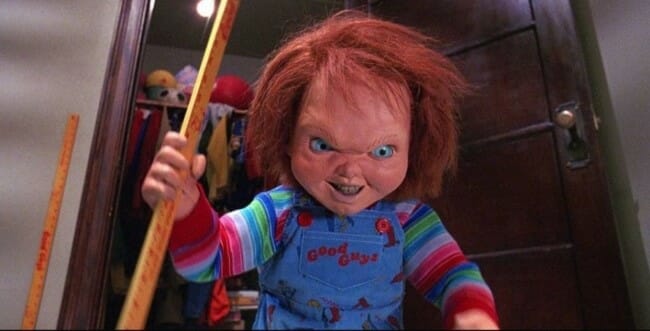
Child’s Play is one of those late ’80s gimmick slashers where it’s all too easy to feel as if you’ve already seen the film, without actually having sat down to watch it. Killer doll, very cheesy, plenty of one-liners, right? Well yes, and no. The original (and pretty obviously best) entry in the Child’s Play series is the most serious-minded (at least slightly) and grounded of the movies, and it goes out of its way to humanize its iconic killer Chucky—or the spirit within him, that of serial killer Charles Lee Ray—more than one might expect. If you’ve never seen a film in the series, ask yourself this: Did you know that the plot of Child’s Play is technically all about voodoo? Because it is. In the end, though, its greatness and inherent watchability boils down to the charms of the wonderful Brad Dourif, who found in Chucky the vessel he needed to become a genre legend forevermore. Like Robert Englund did with Freddy Krueger, Chucky becomes the most beloved aspect of the series because Dourif’s voiceover just oozes charisma and character—he’s more alive than any of the flesh-and-blood characters in this series could ever be. It’s just one of those sublime moments of perfect casting—it’s easy to imagine that no one would remember the Child’s Play series today if that one aspect had been different. —Jim Vorel
32. Scream (2022)
Directors: Matt Bettinelli-Olpin, Tyler Gillett
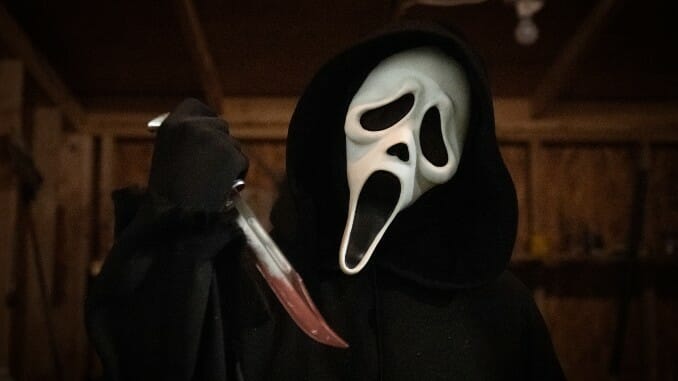
Among many things that ended up winning me over about Radio Silence directing group members Matt Bettinelli-Olpin and Tyler Gillett’s Scream, the main one was that—like its predecessors—it understood how we were going to feel about it before we even got to see it. It knew that I would be torn about its existence. And that, folks, just scratches the surface on why the new Scream, in all its meta-for-a-modern-time goodness, is the best installment since the Wes Craven original. The fifth installment—which takes place 25 years after the original—doesn’t hold back when it comes to analyzing the inner workings of a classic reboot down to the bones. Scream has always been a franchise for film lovers—and it’s never been afraid to be meta as hell, as meta as it needed to be to get its point across. Big questions are raised and left in the air to hang: Are we really just the monsters we create? Are we the monsters that created us, and do we have to be? What is so toxic about loving something with everything you have and wanting it to stay good? Like you’d expect from the franchise, it doesn’t necessarily offer answers to those questions, but the fact that it poses them at all feels right. It is a welcomed dimension to the films that highlights the larger themes that have come into play as the Woodsboro legacy has aged. Sure, the gags about elevated horror and getting back to the roots of slashers, the film trivia, the dedication to the craft of movies—it’s all part of the show. But it’s the fifth movie, and really, why make it if not to send a love letter to the fans? —Lex Briscuso
31. The House on Sorority Row (1983)
Director: Mark Rosman
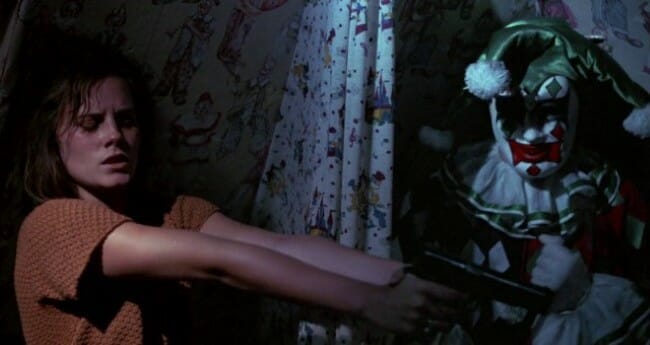
If you dreamt up an early ’80s slasher movie that wasn’t a franchise, it would look very much like The House on Sorority Row. Sororities have always been prime slasher territory, thanks to the preponderance of young female victims living under the same roof—even the first-ever “true” slasher, Black Christmas, was set in a sorority. This one revolves tightly around a group of seven girls who accidentally murder their overbearing house mother in a prank gone wrong … which is itself another major staple as a motivation for early slasher villains. As they try to cover up the crime, members of the group start showing up dead, begging the question of who or what is doing the killing. It’s pretty archetypal stuff, but a fun whodunit from smack dab in the middle of the golden era of the slasher. —Jim Vorel
30. Friday the 13th Part 2 (1981)
Directors: Steve Miner
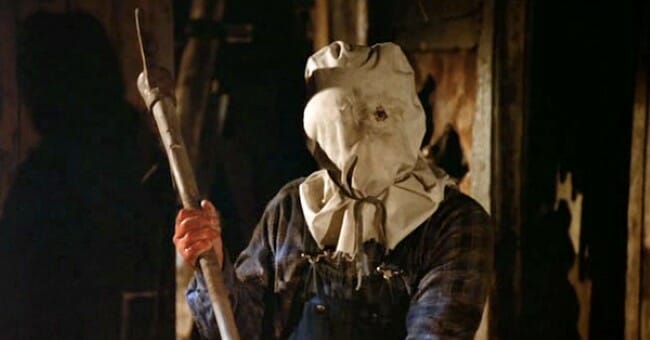
The first sequel to Friday the 13th is remembered today for being “the one that properly introduces Jason as the killer,” but at the same time it’s essentially a refinement of the genre itself. The film simply takes the Voorhees legend established by the first and builds on it, canonizing the ambiguous nature of the first movie’s ending (is Jason really alive?) and confirming that yep, he’s some sort of hulking, deformed backwoods monster, all grown up. Casual viewers are likely to not realize that Jason hasn’t yet acquired his iconic hockey mask at this point in the series—instead, his head is covered in a dirty cheesecloth sack with a single eye hole, which is somehow even creepier. Extra points for final girl Ginny in this installment, as actress Amy Steel imbues her with more inventiveness than most heroines of the early ’80s—especially in the way she quickly understands the nature of Jason’s connection with his mother and uses it to her advantage at the end of the film. If anything, the only area where Part 2 is lacking is the more outlandish kills of the latter films in the series, although it does have one of the genre’s most classic “harbinger” characters in the form of “Crazy Ralph,” who warns the prospective campers that they’re “doomed! You’re all doomed!” He’s pretty much the ultimate example of his particular archetype. —Jim Vorel
29. Friday the 13th (1980)
Director: Sean S. Cunningham
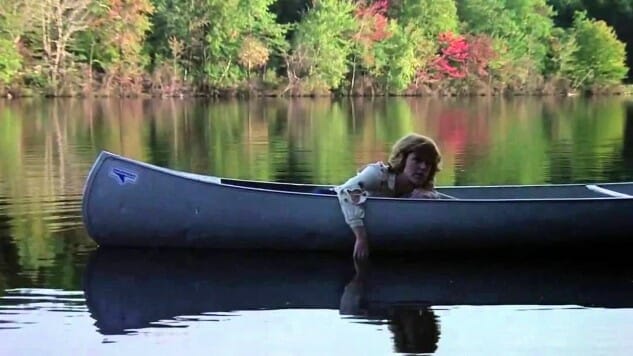
The Friday the 13th movie that launched a thousand imitators: Years after two summer camp counselors are offed while they’re getting it on, a new group with similar extracurricular activities arrives at Camp Crystal Lake. Hack, slice. A pre-Footloose Kevin Bacon (one of the series’ many casting gems) plays a guy who gets lucky and then immediately gets an arrowhead through the back of the throat. Bummer. Friday the 13th is a competent and formative slasher flick, though it barely resembles the series it spawned, in ways both positive and negative. Its impact, however, can’t be argued, and it’s the film most singularly responsible for properly kicking off the slasher boom of the ’80s. Jason makes only a brief, but extremely searing appearance, and the film’s ending reveal can be counted among the most shocking in horror history. —Jeffrey Bloomer
28. Alone in the Dark (1982)
Director: Jack Sholder
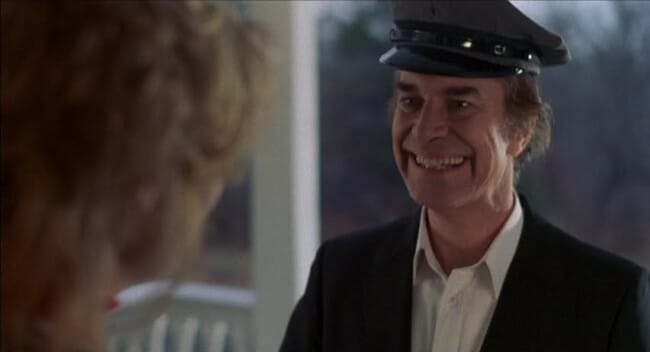
For a product of of the golden era of slashers in the early ’80s, Alone in the Dark is surprisingly unconventional. For the first half, in fact, it barely seems like a slasher movie at all—more an oddball psychological thriller about a psychiatrist who transfers to a new hospital to work alongside a colorful cast of criminally insane characters. That’s the other odd thing about Alone in the Dark—it doesn’t have “a killer,” but instead an entire cast of crazies, each with their own little quirks. There’s paranoid former POW Frank (the ever-grizzled Jack Palance), who believes his psychiatrist is conspiring against him; obese child molester Ronald; pyromaniac preacher Byron; and one psycho simply known as “The Bleeder,” for the fact that his nose bleeds whenever he kills. Add in the fact that their mental hospital is run by the one and only Donald Pleasence, even kookier here than he is as Dr. Loomis, and you’ve got yourself quite the oddball collection of character actors. The inmates eventually escape of course, leading to a second half that is equal parts Assault on Precinct 13 and The Old Dark House. Effective in spurts and bizarre at times, it’s never short of memorable, even if it does take a while to get going. —Jim Vorel
27. The Prowler (1981)
Director: Joseph Zito
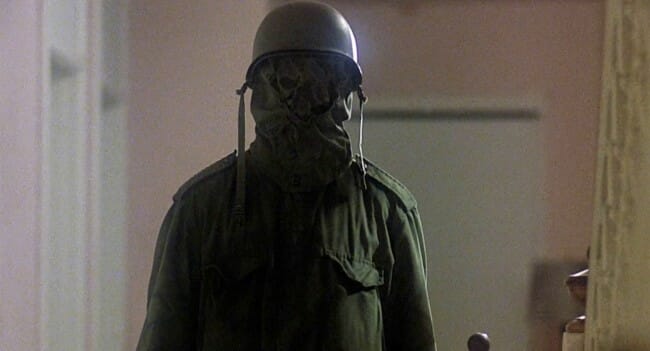
The Prowler isn’t particularly well known, but it’s an excellent example of classical slasher fare from Joseph Zito, better known in horror circles for the well-regarded Friday the 13th IV: The Final Chapter. The setup is extremely familiar, echoing My Bloody Valentine’s “the first dance in ____ years” celebration as the impetus for the revenant of a long-gone killer to resurface. In this case, it’s the titular “prowler,” although “the soldier” might have been a better title, as the killer takes the form of a masked WWII G.I., which allows for some pretty memorable costuming choices. As a whole, the film is a very proficient, if familiar whodunit, highlighted by crisp cinematography, some good-looking chase sequences and some truly nasty bits of gore from Tom Savini. It’s the kind of movie that puts bayonets through people’s heads, and doesn’t skimp on showing you exactly what that might look like. And like all good slashers, it gets one last, good scare in before the end, when the audience is least expecting it. —Jim Vorel
26. Wes Craven’s New Nightmare (1994)
Director: Wes Craven
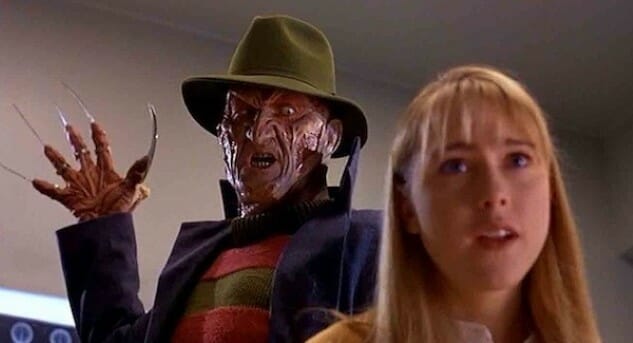
By 1994, 10 years had passed since the original A Nightmare on Elm Street, and Wes Craven had watched a cavalcade of directors run wild with Freddy Krueger in both good (Dream Warriors) and terrible (Final Nightmare) sequels. When he decided to return to the series, the horror visionary therefore came up with a very “proto-Scream” idea—he set the film in the “real world,” casting himself, Robert Englund and the original film’s “final girl,” Heather Langenkamp, as themselves—movie industry people making yet another, unneeded Freddy sequel. Except this time, the malevolent spirit of Freddy—or perhaps the idea of Freddy, starts jumping out into the real world. It’s a concept that perfectly encapsulates the idea of memetics and how it’s applied today on the internet in particular. The actual horror scenes can’t quite match up to the best stuff in parts 1 and 3, but it makes up for it in sheer originality. What New Nightmare does well is rein in the cartoonishness that the series had drifted into in order to make Freddy more clever (and frightening) once again. By approaching it from a new angle, Craven was able to reclaim some of the franchise’s tarnished dignity. —Jim Vorel
25. X (2022)
Director: Ti West
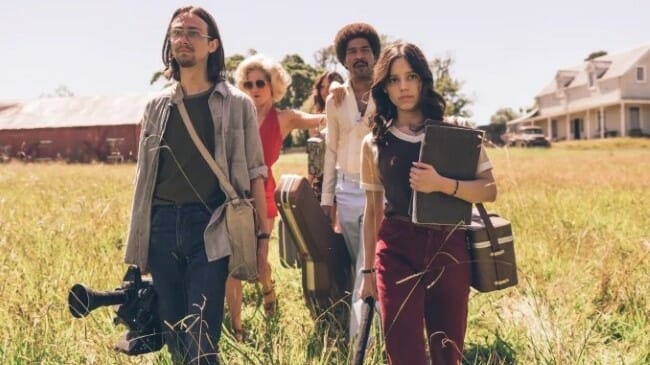
X is a remarkable and unexpected return to form for director Ti West, a decade removed from an earlier life as an “up and coming,” would-be horror auteur who has primarily worked as a mercenary TV director for the last 10 years. To return in such a splashy, way, via an A24 reenvisioning of the classic slasher film, intended as the first film of a new trilogy or even more, is about the most impressive resurrection we’ve seen in the horror genre in recent memory. X is a scintillating combination of the comfortably familiar and the grossly exotic, instantly recognizable in structure but deeper in theme, richness and satisfaction than almost all of its peers. How many attempts at throwback slasher stylings have we seen in the last five years? The answer would be “countless,” but few scratch the surface of the tension, suspense or even pathos that X crams into any one of a dozen or more scenes. It’s a film that unexpectedly makes us yearn alongside its characters, exposes us (graphically) to their vulnerabilities, and even establishes deeply sympathetic “villains,” for reasons that steadily become clear as we realize this is just the first chapter of a broader story of horror films offering a wry commentary on how society is shaped by cinema. Featuring engrossing cinematography, excellent sound design and characters deeper than the broad archetypes they initially register as to an inured horror audience, X offers a modern meditation on the bloody savagery of Mario Bava or Lucio Fulci, making old hits feel fresh, timely and gross once again. In 2022, this film is quite a gift to the concept of slasher cinema. —Jim Vorel
24. Candyman (1992)
Director: Bernard Rose
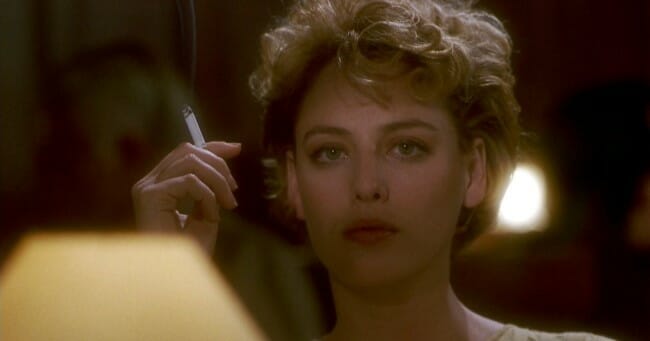
The oeuvre of Clive Barker tends to dwell on dualities and sensuality—pleasure and pain, heaven and hell, brilliance and insanity. They’re all present in Candyman, as they are in other Barker adaptations such as Hellraiser as well, forming a tangled web of romance, abuse and psycho-racial wounds. “Romance” might be an odd word to hear in this instance, but it’s appropriate—Candyman is unusual among slashers for its deep themes of race and taboo, especially as they pertain to sex and love. On the surface an exploration of an urban legend about the ghost of a lynched slave with a hook for a hand, on a deeper level Candyman functions as both a sumptuous gothic romance (aided by its Philip Glass score) à la Crimson Peak and a biting condemnation of government negligence and urban decay in Chicago’s poorest slums. Sometimes Candyman is noir; sometimes it’s sexy; sometimes it’s just plain gross. Tony Todd, as the titular character, has a certain mesmerizing quality that waltzes daintily on the line between farcical and terrifying, while Virginia Madsen as the protagonist actually allowed herself to be hypnotized by her director on set to properly convey the sense of falling under the Candyman’s spell. In terms of uniqueness alone, Candyman earns its own strange, little corner in the slasher canon. —Jim Vorel
23. A Bay of Blood, a.k.a. Twitch of the Death Nerve (1971)
Director: Mario Bava
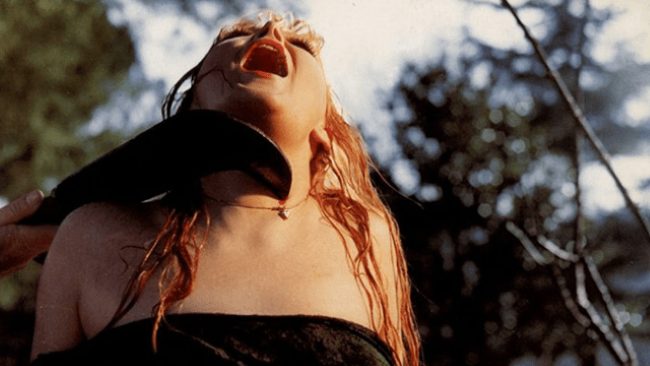
A Bay of Blood, released in the U.S. as Twitch of the Death Nerve, is the most important proto-slasher to often get left out of conversations on the history of the slasher genre, and this simply will not stand. Although many Italian giallos of the ̵]7;70s have slasher elements and pre-date the likes of Black Christmas and Halloween, none of them have kills that so directly seem like something out of a Friday the 13th movie. And indeed, that series borrows heavily from A Bay of Blood, especially Friday the 13th Part 2, which recreates two of Bava’s the death sequences almost exactly—most notably the bit where two lovers get impaled on a spear in mid-copulation. It’s Bava’s goriest film without a doubt, although not his most visually striking or narratively sensible, in terms of plot—all of the killings basically revolve around obtaining land ownership. That uneven nature and lack of compelling characters holds it back slightly, but when he’s throwing the red paint around, A Bay of Blood is enjoyably lurid. —Jim Vorel
22. Sleepaway Camp (1983)
Director: Robert Hiltzik
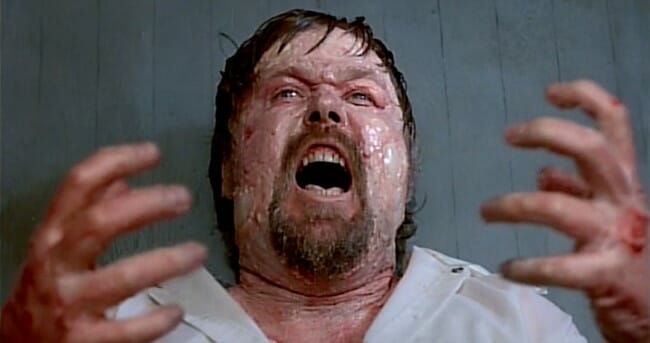
Of all the camp-based Friday the 13th rip-offs, Sleepaway Camp is probably the best one that isn’t The Burning. Our main character is Angela, a troubled girl who absolutely everyone picks on for no good reason. Seriously—it’s one of those ’80s era movies with a main character who is an “outsider” constantly harassed by dozens of people, but without any impetus or explanation—it’s just Angela’s lot in life. Everyone who meets her immediately hates her guts and subjects her to cruel taunting. But soon, the people at the camp who were mean to Angela start getting knocked off. The movie seems calculated to come off as a straight horror film, but the death scenes are often so outlandish that it veers pleasurably into horror comedy, as well. Highlights include the lecherous camp cook, who gets a giant vat of boiling water dumped on his face, or the kid who gets a beehive dropped into the outhouse with him. If you love classic slashers, it’s a must-see, especially for the ending. I won’t spoil anything, but Sleepaway Camp can proudly lay claim to one of the most shocking, WTF endings in slasher movie history. —Jim Vorel
21. You’re Next (2011)
Director: Adam Wingard
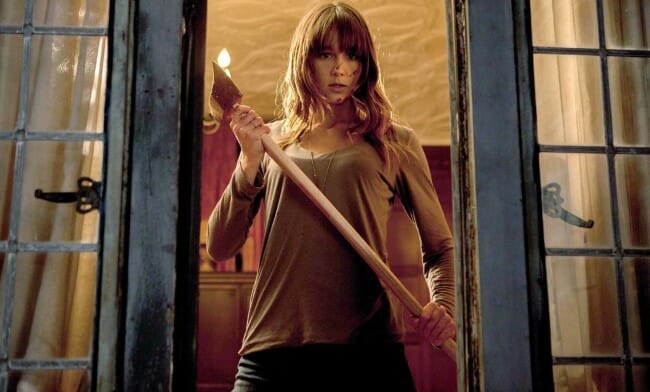
Between A Horrible Way to Die, The Guest and You’re Next (let’s forget about the Blair Witch remake entirely), it’s easy to understand why Adam Wingard is still considered an upcoming director of interest. His films have a verve and sense of pacing that just crackles—they’re lean, mean and get to the point. You’re Next immediately sets up a premise that we’ve seen many times before, that of the “home invasion” style of horror-thriller, before subverting the genre’s expectations when our Final Girl proves to be far more adept and capable than any of the audience members realized—a moment that also transforms the film from “home invasion” into more of a pure slasher. From there, the story becomes more complex, as motivations and secret histories are revealed. The action, importantly, is viscerally shot and impactful, making for a film where each physical confrontation has real, concrete consequences. Hell, it’s even a little funny now and then. Given that The Guest is a bit more thriller than horror, You’re Next remains Wingard’s best pure horror work to date. —Jim Vorel
20. Behind the Mask: The Rise of Leslie Vernon (2006)
Director: Scott Glosserman

In the years following Scream, there was no shortage of films attempting similar deconstructions of the horror genre, but few deserve to be mentioned in the same breath as the criminally underseen Behind the Mask. Taking place in a world where supernatural killers such as Jason Voorhees and Freddy Krueger actually existed, this mockumentary follows around a guy named Leslie Vernon (Nathan Baesel), who dreams of being the “next great psycho killer.” In doing so, it provides answers and insight into dozens of horror movie tropes and clichés, like: How does the killer train? How does he pick his victims? How can he seemingly be in two places at once? It’s a brilliant, twisted love letter to the genre that also develops an unexpected stylistic change right when you think you know where things are headed. And, despite a lack of star power, Behind the Mask boasts tons of cameos from horror luminaries: Robert Englund, Kane Hodder, Zelda Rubinstein and even The Walking Dead’s Scott Wilson. Every, and I mean every, horror fan needs to see Behind the Mask. It’s criminal that Glosserman has never managed to put together a proper sequel, but a fan-funded comic series raised twice its goal on IndieGoGo, so maybe it’s still possible. —Jim Vorel
19. Friday the 13th IV: The Final Chapter (1984)
Director: Joseph Zito

Here’s a fun game: Find someone without much knowledge of the horror genre, and ask them to guess what number in the Friday the 13th series bears the subtitle The Final Chapter. Then, when they answer, inform them that there were eight more movies featuring Jason made after this one, which was already number four. Regardless, Final Chapter is universally well liked by fans of this series, and is often cited as one of the best, or at least in the top three, of the seminal slasher franchise. Much of it is character driven—this is the film that introduces the kid who would rightfully be considered Jason’s “arch enemy,” Tommy Jarvis, here played by a rather unsettling Corey Feldman one year before The Goonies. Jason himself has also matured into a fully powered engine of destruction by this point, and his physicality is top notch, as he comes bursting through windows, doors and literally anything in his way. The film even has a memorable appearance from a young-ish Crispin Glover, also a year before Back to the Future, playing a neurotic, Woody Allen-esque teenager determined to score. The scene of his spastic, improvisational ’80s dancing is nothing short of legendary. —Jim Vorel
18. Stage Fright, a.k.a. Aquarius (1987)
Director: Michele Soavi
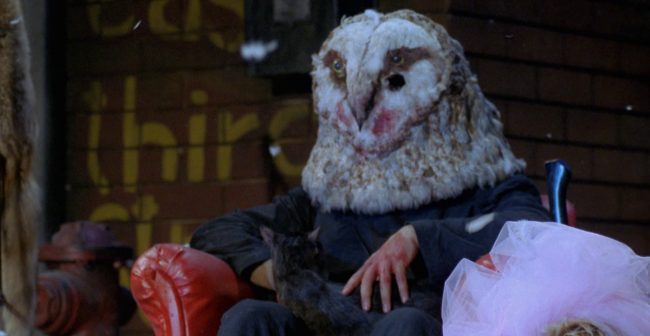
Stage Fright is what it looks like when Italian giallo films inform the American slasher genre, and then American slasher films return the favor by inspiring Italian imitation. Michele Soavi, perhaps better known in horror circles for 1994’s truly unique Cemetery Man, created this fusion of Argento-esque Italian horror (he was second unit director on Tenebrae and Argento’s similar film Opera) and American “escaped maniac on the loose” movies as an imaginative, gory dreamscape, and one that stands out as much for its ethereal visuals as it does for its shocking gore factor. Set overnight in a theater, where a troupe of actors is working overtime to premiere a new show about a homicidal killer, life of course ends up imitating art. The killer stalks the various nubile young actors dressed in an unusual owl costume, increasingly mottled with blood in its feathers as he impales or disembowels them. There’s a fantastical quality to Stage Fright that is its signature—a painterly quality to its beautiful set pieces that elevates it beyond the gratuitous violence. Although it takes a while to get going, once the killings begin, Stage Fright becomes a waking nightmare. —Jim Vorel
17. My Bloody Valentine (1981)
Director: George Mihalka
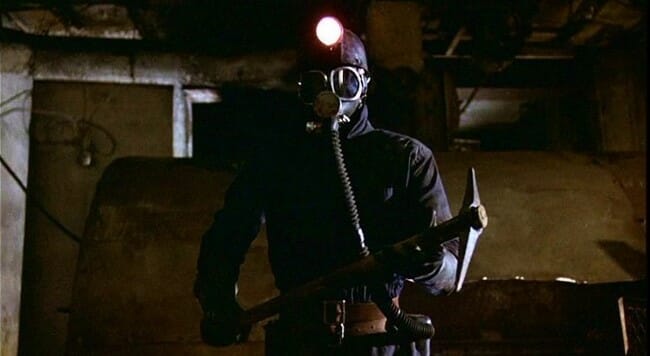
Practically every holiday of note got their own quasi-slasher film in the wake of Friday the 13th, but it’s the Valentine’s Day entry that stole our hearts. This film is the archetype for just about every early ’80s slasher from top to bottom: “Anniversary of the day it all happened” setting, wronged antagonist returning decades later, masked killer, horny teens, and red herrings aplenty. It was infamous at the time for its gore, but audiences never knew the half of it in 1981—if you watch this film today, it’s imperative that you obtain the 2009 uncut version (not the 2009 remake), which adds back in a ton of footage from the gory death scenes, especially the bit in the showers when one particularly unfortunate girl gets her head impaled by a spout, which then gets turned on. Suffice to say, it’s not pretty. Beyond the gore, there’s something inherently likable about My Bloody Valentine’s particular brand of familiarity—it feels like the cinematic equivalent of a letter in the mail from an old friend. This is basically slasher comfort food—the good kind. —Jim Vorel
16. Tenebrae (1982)
Director: Dario Argento
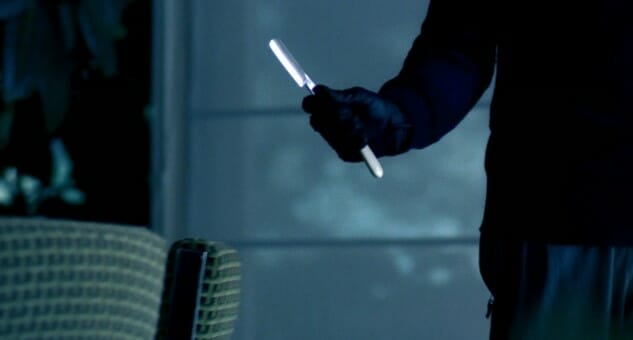
If you wrote an ultra-violent horror book, and if your ultra-violent horror book inspired a workaday psycho to go on their own ultra-violent killing spree, would you be put off or would you take it as a compliment? Maybe that’s not the question Dario Argento asks in his notorious 1982 giallo film Tenebrae, but the plot does call to mind a certain old proverb about imitation and flattery: American author Peter Neal (Anthony Franciosa) heads to Italy to promote his new book, and finds that there’s a serial killer on the loose, emboldened by Neal’s bibliography and murdering Romans in his name. That’s gotta feel pretty good for Neal, though not so much for the killer’s victims. The guy isn’t exactly into efficiency; he prefers to make his prey suffer, which shouldn’t come as a surprise given Tenebrae’s source. (Argento isn’t into efficiency, either. He’ll kill people with random stockpiles of razor wire if he feels like it.)
Tenebrae, more so than other Argento movies, is tough to watch; it’s an especially bloody affair, but its artistic merit demands we consider it essential cinema. The film stages arterial geysers to soak its sets in crimson equally as often as it admits Argento’s own twisted indulgences as a filmmaker. He opens the film with a narration about finding freedom in taking life, for Christ’s sake. You figure it out. It’s not that Argento condones murder or anything as nutty as that; it’s more that he’s willing to confess his hopeless fixation with depicting murder on screen. When you’re possessed of as great a gift for that kind of thing as Argento, what reasonable person can blame you? —Andy Crump
15. The Funhouse (1981)
Director: Tobe Hooper
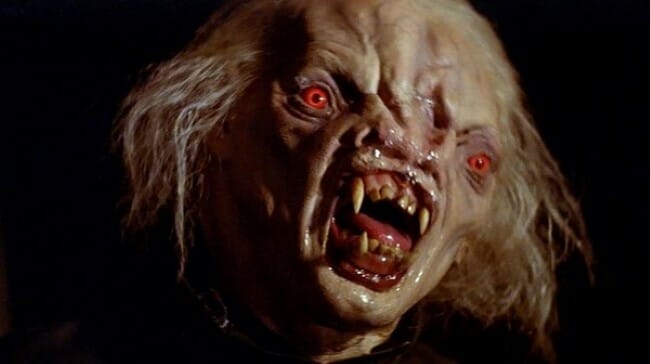
The setting and synopsis of The Funhouse seem unassuming, but director Tobe Hooper packs the film with far more verve and unsettling imagery than one might expect. Hooper’s vision of “the carnival” is one that doesn’t glamorize the nomad’s life in the least—the proprietors of this traveling establishment are one of the strangest, most unnerving and coarse collections of extras ever assembled, to the point that it’s difficult to tell where the freak show ends and the carnival employees begin. They completely steal the film away from its would-be protagonists, a gaggle of teenagers who decide to secretly spend the night inside the carnival funhouse, before witnessing a murder and being set upon by a deformed killer. That killer, the mutant son of the carnival’s owner, is truly a nightmarish-looking beast, with incredible mask/makeup work that is only matched by the sheer intensity of actor Wayne Doba’s portrayal. His hyperkinetic, frenzied motions as the monster are capable of both frightening and garnering the character an unexpected degree of sympathy—it’s worth seeing The Funhouse just for this character’s physicality alone. Light on plot but with style to spare, it’s one of the best ’80s slashers to consistently fly under the radar, despite having Tobe Hooper’s name attached. —Jim Vorel
14. A Nightmare on Elm Street 3: Dream Warriors (1987)
Director: Chuck Russell
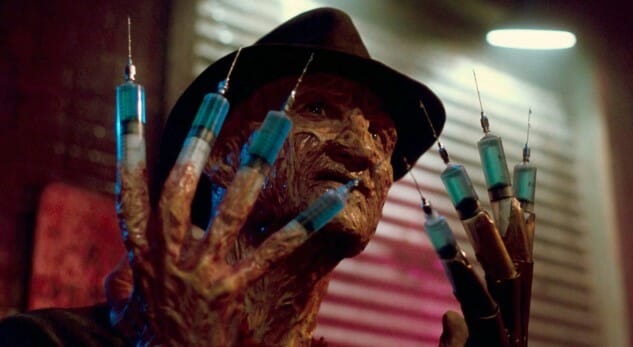
Dream Warriors is almost invariably hailed as the best of the Nightmare on Elm Street sequels, and this is one case where the horror fans aren’t wrong—although The Dream Master and New Nightmare are both solid, as well. After the oddball diversion (and famous gay subtext) of the first sequel, Freddy’s Revenge, Dream Warriors benefits greatly from a returning Heather Langenkamp as top tier final girl Nancy Thompson, now grown up and attempting to help a new generation of kids fight back against the pure evil that is Freddy Krueger. It’s a film that benefits from a perfect supporting cast of dreamers, all battling their own personal demons, but of course it’s Robert Englund who steals the show as Freddy. Building upon his persona from the first two Nightmare installments, this film is the zenith of “funny Freddy” as an archetype, expertly balancing the character’s menace with deadly one-liners that are instantly iconic. Every death scene in Dream Warriors is memorable, while the dream sequences are more unbound than ever. If the original A Nightmare on Elm Street is the series at its most frightening, then Dream Warriors is perhaps the series at its most purely entertaining—the mold that lesser sequels were always trying to duplicate in the years that followed, with diminishing returns. —Jim Vorel
13. Friday the 13th Part VI: Jason Lives (1986)
Director: Tom McLoughlin
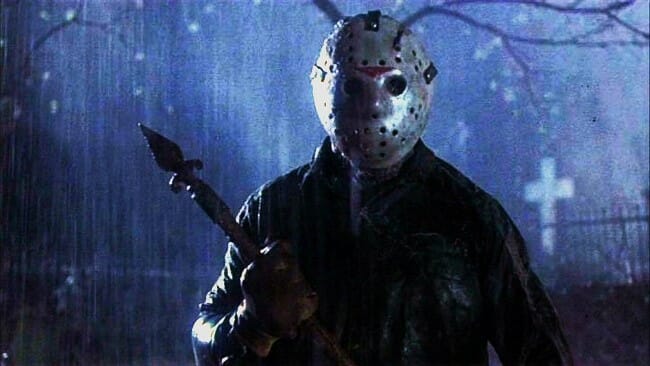
It’s a bit of a sleeper pick, but one that has become more defensible over time as its stock grows—of all the Friday the 13th movies, the most purely entertaining entry falls right in the middle of the series: Part VI, Jason Lives. A near perfect amalgam of everything we love about late ’80s era slasher movies, it’s an expertly balanced melange of jump scares, goofy characters, comic ultraviolence, spooky settings and gratuitous titillation. Tommy Jarvis from The Final Chapter returns as a grown man after the disappointing and confusing fifth installment of the series, unable to accept the fact that Jason is actually dead. Naturally, his attempts to make sure end up resulting in Voorhees actually reanimating as a truly undead killing machine for the first time, and we’re off to the races. Jason stacks up a truly absurd body count in this entry, dispatching minor characters and cannon fodder with the greatest of ease and stylish panache. The film winks at the audience quite a bit, critiquing their taste in tawdry slashers even while it delivers one of the most fun, vibrant examples of the genre from the mid-’80s. It’s self-aware in all the best ways, because its awareness never stops it from giving the paying audience exactly what they came to see. —Jim Vorel
12. Scream (1996)
Director: Wes Craven
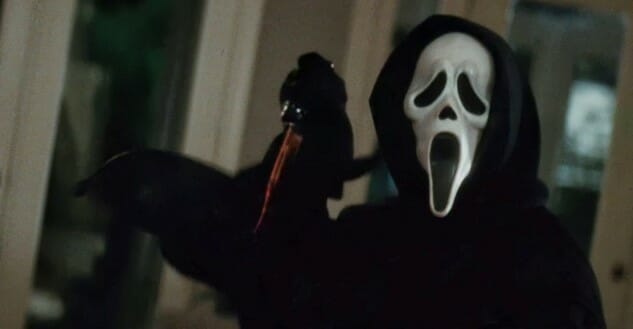
Before Scary Movie or A Haunted House were even ill-conceived ideas, Wes Craven was crafting some of the best horror satire out there. And although part of Scream’s charm was its sly, fair jabs at the genre, that didn’t keep the director from dreaming up some of the most brutal knife-on-human scenes in the ’90s—a decade where many thought the slasher genre had faded away, never to be seen again. With the birth of the “Ghost Face” killer, Craven took audiences on a journey through horror-flick fandom, making all-too-common tricks of the trade a staple for survival: sex equals death, don’t drink or do drugs, never say “I’ll be right back.” With a crossover cast of Neve Campbell, Courteney Cox, David Arquette, Matthew Lillard, Rose McGowan and Drew Barrymore (okay, for like 10 minutes), Scream arrived with a smart, funny take on a tired genre. It wasn’t the first film of its kind, but it was the first one to be seen by a huge audience, which went a long way in raising the “genre IQ” of the average horror fan. —Tyler Kane
11. Opera (1987)
Director: Dario Argento
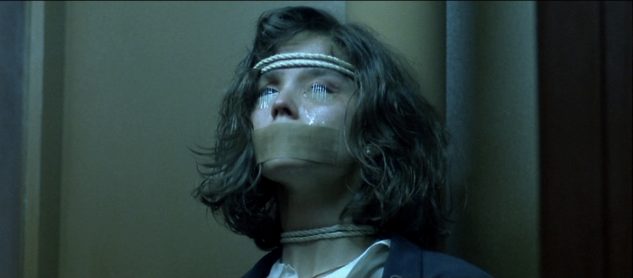
Giallo is not the kind of genre in which directors end up receiving a lot of critical aplomb—with the occasional exception of Dario Argento. He is to the bloody, Italian precursor to slasher films as, say, someone like Clive Barker is to more westernized horrors: an auteur willing to take chances, whose gaudy works are occasionally brilliant but just as often fall flat. Opera, though, is one of Argento’s most purely watchable films, following a young actress (Cristina Marsillach) who seems to have developed a rather homicidal admirer. Anyone who gets in the way of her career has a funny way of ending up dead, and her constant nightmares hint at a long-buried connection to the killer. Essentially the giallo equivalent of Phantom of the Opera, Opera’s canvas is splashed with Argento’s signature color palette of bright, lurid tones and over-the-top deaths. If you love a good whodunnit, and especially if you have an interest in cinematography, Opera is a primer in horror craftsmanship. —Jim Vorel
10. Alice, Sweet Alice (1976)
Director: Alfred Sole
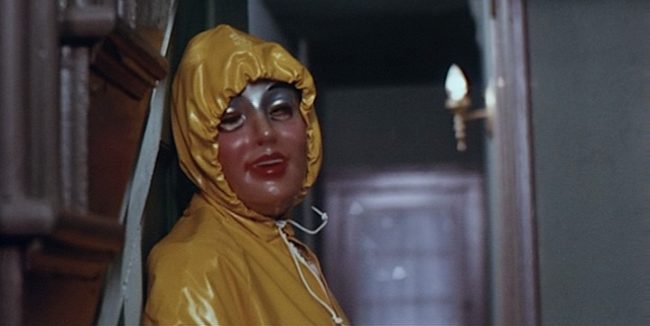
Alice, Sweet Alice is one of the most fascinating of proto-slashers, arriving after the limited exposure of 1974’s Black Christmas but before Halloween rooted slasher conventions indelibly in the American psyche. It’s a film that wears its inspirations on its sleeve, whether it’s the Psycho poster that shows up in one scene or the many, many visual flourishes and motifs that seem to draw comparison to the films of Dario Argento and Mario Bava—particularly Argento’s Deep Red. In fact, Alice, Sweet Alice could rightly be called one of the most giallo-esque American films ever made, fusing a seeming obsession/fetishization with Catholic dogma into a murder mystery whodunit that does not skimp on the arterial spray. The story concerns a young girl who is murdered by a mysterious, masked killer during her first communion, leading to suspicion falling on the girl’s older, jealous sister, Alice. Is Alice a budding psychopath? Or is she surrounded by them on all sides? Alice, Sweet Alice features a collection of some truly loathsome characters, from the morbidly obese, cat-obsessed landlord of her building to her shrill aunt, who detests Alice’s very guts. Moody, melodramatic and genuinely chilling in some of its quiet, stalker-ish moments, Alice, Sweet Alice runs the gamut from emotionally harrowing to violently perverse. —Jim Vorel
9. The Burning (1981)
Director: Tony Maylam
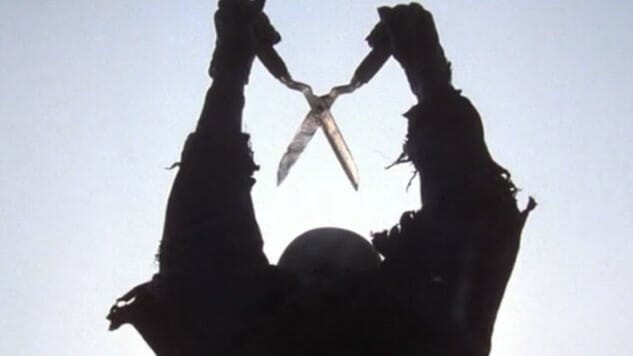
If Halloween codified many of the slasher conventions in 1978, then Friday the 13th opened the floodgates wide to imitation with its unexpected success and profitability in 1980. A slew of imitators and low-rent slashers poured into drive-ins and grindhouses in the decade that followed, but The Burning is one of the few to rise above the scrum. At first it seems just like one of the pale Friday the 13th imitators, aping the summer camp setting much in the same way as Sleepaway Camp would later do, but there’s an artistry and shocking quality to the violence and gore here that isn’t present in most of the copycats, which were more interested in titillation rather than genuine surprise. Drawing upon the New York urban legend/campfire story of “Cropsey,” which tells of a disfigured camp counselor returned from a presumed grave to seek vengeance on counselors, The Burning takes its time and lures the audience into a rather effective false sense of security through establishing a lighthearted tone and scenes of counselors scaring each other. That status quo is eventually shattered in one of the more amazing early-’80s scenes of slasher carnage, which occurs when Cropsey (Lou David) ambushes an entire raft full of counselors and campers and systematically dispatches them in the most grisly format imaginable. It must have had audience members excusing themselves to flee the theater at the time. —Jim Vorel
8. Blood and Black Lace (1964)
Director: Mario Bava
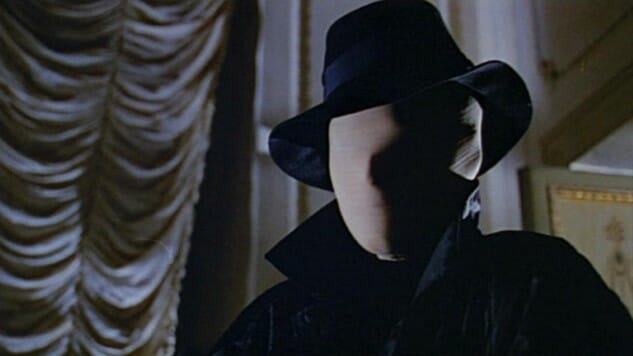
You can credit films such as Psycho or Peeping Tom for laying the groundwork for the slasher genre, and 1974’s Black Christmas for first bringing all the elements together into what is undeniably a “slasher movie,” but Mario Bava’s foundational 1964 giallo is so close as to almost merit that title as the first “true” slasher in almost every way that matters. Blood and Black Lace is an absolutely gorgeous, sumptuous movie that is all the better to see on the big screen, if you can, featuring dramatic splashes of primary colors used to maximum impact. The story is a blend of darkly comic murder mystery and titillation-tinged exploitation, featuring a gaggle of female models stalked by a mysterious assailant whose face is covered in an impenetrable stocking mask with blank features—a killer who looks for all intents and purposes like the DC Comics character The Question. It’s an immediately iconic image that seared its imprint into an entire Italian genre, and subsequent killers would reflect so many of this character’s features, from the black gloves and long coat to the mask itself. Although many tried to ape its visuals, very few could match the decadence and the sense of luxurious (and deadly) excess that Bava captures in Blood and Black Lace. —Jim Vorel
7. Deep Red (1975)
Director: Dario Argento
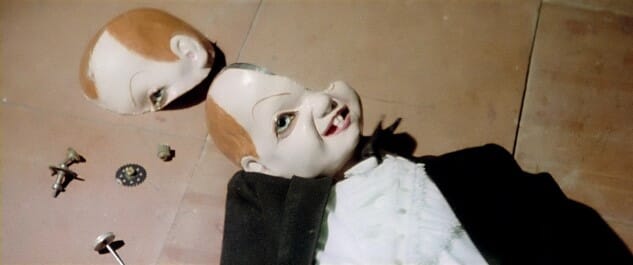
Dario Argento’s movies would be easy to pick out of a police lineup, because when you add all of his little quirks together they form an instantly iconic style. Deep Red is one of those films that simply couldn’t have been made by anyone else—Mario Bava could have tried, but his wouldn’t have the quintessential soundtrack by Argento collaborators Goblin, nor the drifting, eccentric camerawork that constantly makes us question whether we’re looking through the killer’s POV or not. And the story is a classic giallo whodunit: Following the brutal cleaving of a German psychic (Macha Méril), a music teacher (David Hemmings) who lives in her building starts putting the pieces together to solve the murder mystery, uncovering a tragic family history. Along the way, anyone who gets close to the answer gets a meat cleaver to the head from a mysterious assailant in black leather gloves—except for those who die in much worse, more gruesome ways. Argento has a real eye for what is physically disconcerting to watch—he somehow takes scenes that are “standard” for the horror genre and makes them much more uncomfortable than one would think by simply reading a description of the sequence. In Argento’s hands, a slashing knife becomes a paintbrush. —Jim Vorel
6. The Texas Chain Saw Massacre (1974)
Director: Tobe Hooper
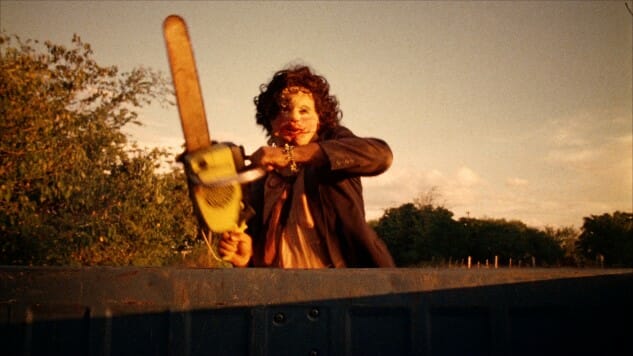
One of the most brutal mainstream horror films ever released, The Texas Chain Saw Massacre, based on notorious Wisconsin serial killer Ed Gein, resembles art-house verité built on the grainy physicality of its flat Texas setting. Plus, it introduced the superlatively sinister Leatherface, the iconic chainsaw-wielding giant of a man who wears a mask made of human skin, whose freakish sadism is upstaged only by the introduction of his cannibalistic family with whom he resides in a dilapidated house in the middle of the Texas wilderness, together chowing on the meat Leatherface and his brothers harvest, while Grandpa drinks blood and fashions furniture from victims’ bones. Still, The Texas Chain Saw Massacre might not be the goriest horror film ever made, but as an imaginal excavation of the subterranean anxieties of a post-Vietnam rural American populace, it’s pretty much unparalleled. Twisted, dark and beautiful all at once, it careens through a wide variety of tones and techniques without ever losing its singular intensity. (And there are few scenes in this era of horror with more disturbing sound design than the bit where Leatherface ambushes a guy with a single dull hammer strike to the head before slamming the metal door shut behind him.) —Rachel Hass and Brent Ables
5. Peeping Tom (1960)
Director: Michael Powell
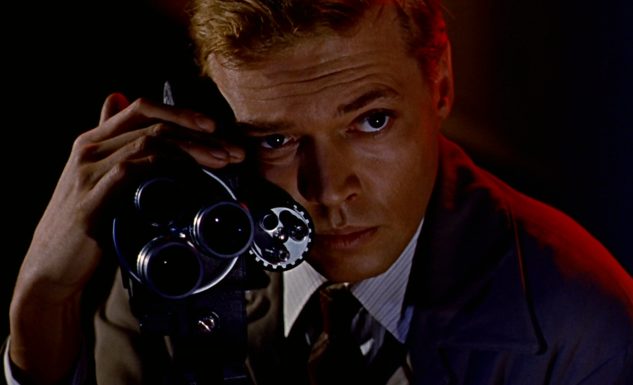
In one respect, Michael Powell’s Peeping Tom is a meticulous, human, thoughtful movie about the mechanics and emotional impulses that drive the filmmaking process. In another, it’s a slasher flick about a loony tune serial killer-cum-documentarian who murders people with his camera’s tripod. (The tripod has a knife on it.) Basically, Peeping Tom is precisely as silly or as serious as you care to read it, though as absurd as the premise sounds on the page, the film is anything but on the screen. In fact, it was considered quite controversial for a time—and depending on whom you ask, it may still be. Understanding why doesn’t take a whole lot of heavy lifting; movies about women in peril have a way of striking their audience’s nerves, and Peeping Tom takes that idea to an extreme, giving its slate of victims-to-be little room to breathe as Mark Lewis (Carl Boehm) closes in on them, capturing their exponentially increasing fear from second to second as they face dawning comprehension of their impending deaths. It’s a tough film to sit through, as any film about a psychopath with a habit of brutally slaying women would be, but it’s also thorough, insightful, impeccably made and brilliantly considered. —Andy Crump
4. Psycho (1960)
Director: Alfred Hitchcock
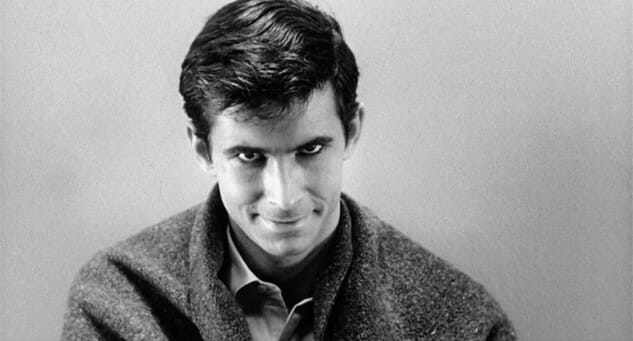
The big one. The biggest one, perhaps, though if not, it’s still pretty goddamn big. Almost 60 years after Alfred Hitchcock unleashed Psycho on an unsuspecting moviegoing culture, finding new things to say about it feels like a fool’s errand, but hey: Five decades and change is a long time for a movie’s influence to continue reverberating throughout popular culture, but here we are, watching main characters lose their heads in Game of Thrones, their innards in The Walking Dead, or their lives, in less flowery language, in films like Alien, the Alien rip-off Life and, maybe most importantly, Scream, the movie that is to contemporary horror what Psycho was to genre movies in its day. That’s pretty much the definition of “impact” right there (and all without even a single mention of A&E’s Bates Motel).
But now we’re talking about Psycho as a curio rather than as a film, and the truth is that Psycho’s impact is the direct consequence of Hitchcock’s mastery as a filmmaker and as a storyteller. Put another way, it’s a great film, one that’s as effective today as it is authoritative: You’ve never met a slasher (proto-slasher, really) like Norman Bates (Anthony Perkins), and no matter how many times the movies try to replicate his persona on screen, they’ll never get it quite right. He is, like Psycho itself, one of a kind. Note: If this was purely a ranking of “the best films that qualify as slashers,” Psycho might well be #1, but it’s not quite “the ultimate slasher movie,” despite its greatness as a film. —Andy Crump
3. Black Christmas (1974)
Director: Bob Clark
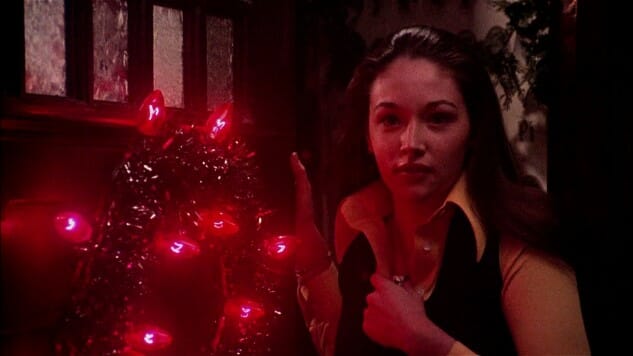
Fun fact—nine years before he directed holiday classic A Christmas Story, Bob Clark created the first true, unassailable “slasher movie” in Black Christmas. Yes, the same person who gave TBS its annual Christmas Eve marathon fodder was also responsible for the first major cinematic application of the phrase “The calls are coming from inside the house!” Black Christmas, which was insipidly remade in 2006, predates John Carpenter’s Halloween by four years and features many of the same elements, especially visually. Like Halloween, it lingers heavily on POV shots from the killer’s eyes as he prowls through a dimly lit sorority house and spies on his future victims. As the mentally deranged killer calls the house and engages in obscene phone calls with the female residents, one can’t help but also be reminded of the scene in Carpenter’s film where Laurie (Jamie Lee Curtis) calls her friend Lynda, only to hear her strangled with the telephone cord. Black Christmas is also instrumental, and practically archetypal, in solidifying the slasher trope of the so-called “final girl.” Jessica Bradford (Olivia Hussey) is actually among the better-realized of these final girls in the history of the genre, a remarkably strong and resourceful young woman who can take care of herself in both her relationships and deadly scenarios. It’s questionable how many subsequent slashers have been able to create protagonists who are such a believable combination of capable and realistic. —Jim Vorel
2. A Nightmare on Elm Street (1984)
Director: Wes Craven
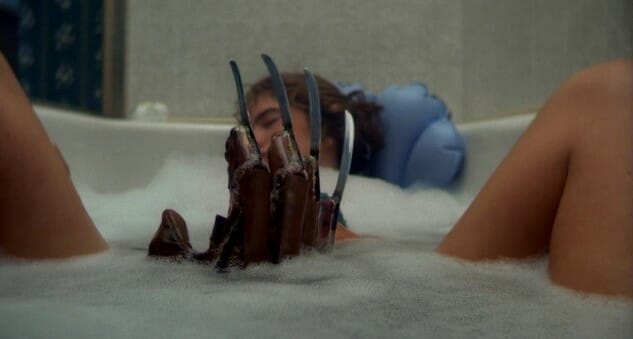
Of the big three slasher franchises—Halloween, Friday the 13th and this—it’s A Nightmare on Elm Street that arguably presented us with the most complete and perfectly polished of original installments. No doubt this is a factor of being the last to come along, as Wes Craven had a chance to watch and be influenced by the brooding Carpenter and the far more shameless and tawdry Cunningham in several F13 sequels. What emerged from that stew of influences was a killer who shared the indestructibility of Myers or Voorhees, but with a twist of Craven’s own demented sense of humor. That’s not to say Freddy Krueger (Robert Englund) is a comedian—at least not here in the first Nightmare, where he’s presented as a serious threat and a genuinely frightening one at that, rather than the self-parodying pastiche he would become in sequels such as Final Nightmare—but his gleeful approach toward murder and subsequent gallows humor make for a very different breed of supernatural killer, and one that proved extremely influential on post-Nightmare slashers. The film’s simple premise of tapping into the horrors of dreaming and questionable reality was like a gift from the gods presented directly to the artists and set designers, given carte blanche to indulge their fantasies and create memorable set pieces like nothing else ever seen in the horror genre to that point. It’s a phantasmagoria of morbid humor and bad dreams. —Jim Vorel
1. Halloween (1978)
Director: John Carpenter
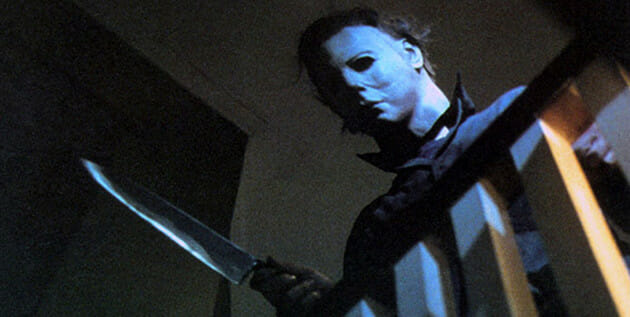
For students of John Carpenter’s filmography, it is interesting to note that Halloween is actually a significantly less ambitious film than his previous Assault on Precinct 13 on almost every measurable level. It doesn’t have the sizable cast of extras, or the extensive FX and stunt work. It’s not filled with action sequences. But what it does give us is the first full distillation of the American slasher film, and a heaping helping of atmosphere. Carpenter built off earlier proto-slashers such as Bob Clark’s Black Christmas in penning the legend of Michael Myers, an unstoppable phantom who returns to his hometown on Halloween night to stalk high school girls. (The original title was actually The Babysitter Murders, if you haven’t heard that particular bit of trivia before.) Carpenter heavily employs tools that would become synonymous with slashers, such as the killer’s POV perspective, making Myers into something of a voyeur (he’s just called “The Shape” in the credits) who lurks silently in the darkness with inhuman patience before finally making his move. It’s a lean, mean movie with some absurd characterization in its first half (particularly from the ditzy P.J. Soles, who can’t stop saying “totally”) that then morphs into a claustrophobic crescendo of tension as Jamie Lee Curtis’ Laurie Strode first comes into contact with Myers. Utterly indispensable to the whole thing is the great Donald Pleasance as Dr. Loomis, the killer’s personal hype man/Ahab, whose sole purpose in the screenplay is to communicate to the audience with frothing hyperbole just what a monster this Michael Myers really is. It can’t be overstated how important Pleasance is to making this film into the cultural touchstone that would inspire the early ’80s slasher boom to follow. —Jim Vorel
Jim Vorel is Paste‘s movie editor and resident horror geek. You can follow him on Twitter for more film writing.







































